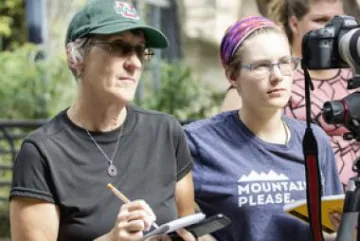UA Student Film Looks at New Type of Zoo
"A Modern Zoo," a short documentary produced by a science journalism class of 18 students, shows how animal welfare, conservation and education are all important functions of Tucson's Reid Park Zoo.
Would you believe that the producer of a documentary film didn’t even own a camera before she started work on the project? Or that a retired statistics professor could become a journalist? Or that a graduate student, feeling tapped out as a writer, could learn on the fly to do the job of a graphic artist?

All of the above happened in barely two months' time as University of Arizona students in Carol Schwalbe's science journalism class decided on their own to make "A Modern Zoo," a 15-minute film that uses Tucson's Reid Park Zoo to illustrate how animal welfare, conservation and education all converge in modern-day zoos.
Schwalbe, a former editor at National Geographic magazine, launched the class in 2011, shortly after arriving at the UA from Arizona State University. Typically, the students self-produce a magazine as a project, but this fall's class of 18 students wanted to do more after seeing a range of storytelling angles at the Tucson zoo.
"So many of the (written) pieces were coming back to the idea that zoos are different now," says junior Marissa Heffernan, the producer whose inexperience with a camera is impossible to discern from the highly polished final cut.
With UA alumni Alan Scott Davis, Julian Ybarra and John de Dios serving as mentors, the group laid the groundwork in October. The students went into full production mode after the sales-tax increase benefiting Reid Park Zoo passed on Nov. 7. In all, they recorded more than 20 interviews with zoo staff as well as UA experts John Koprowski, Dieter Steklis and Shane Burgess.
Their crew included Chris Stidley, the former statistics professor who loved the class so much that she has decided to pursue a master's degree in journalism, and Alyssa Hill, who was ready to drop the class but stayed on to learn the Adobe After Effects graphics application that adds to the impact of "A Modern Zoo."
Another UA alumnus, Nick Lunn, currently a video producer and editor at National Geographic, dropped in recently to provide feedback.
"This was like a crash course for them (in video)," Lunn says. "Video is very complex, with a lot of moving parts. There are technical aspects to learn, but also interviewing for video is different."

The project also was blessed with some good fortune when a chance meeting with UA music students Nat Anderson and Autumn Dominguez led to the creation of an original score for the film.
"We met with them on a Saturday evening," Davis says, "and by Monday morning we had 10 songs. So much of this project was student work, but I never thought we could get student music, as well."
The credit for inspirational leadership, Davis and the students agree, goes to Schwalbe.
"I took this class three years ago, and it totally changed my life," says Davis, who has freelanced for National Geographic and helped produce videos for Canon USA and ARRI. "It all comes from Carol, the way she lays it out.
"This kind of work is attainable (at the UA). We've had multiple professors say that it's the best student journalism project, period."
Says Heffernan: "Carol gives you the freedom to follow your interests. I learned an entirely new skill in two months and didn't think that was possible."
Other students who worked on "A Modern Zoo" include Nick Smallwood (cinematography), Carly Oseran (assistant producer), Elizabeth Kinney (photography) and Naomi Pier (reporter). Assistance on the project also was provided by the UA's Dane Velasquez (UITS, for color correcting and audio) and Anna Augustowska (School of Social and Behavioral Sciences, for storyboarding).
You can watch the full documentary "A Modern Zoo"
Story written by Doug Carroll, University Communications
Original story from UANews.

